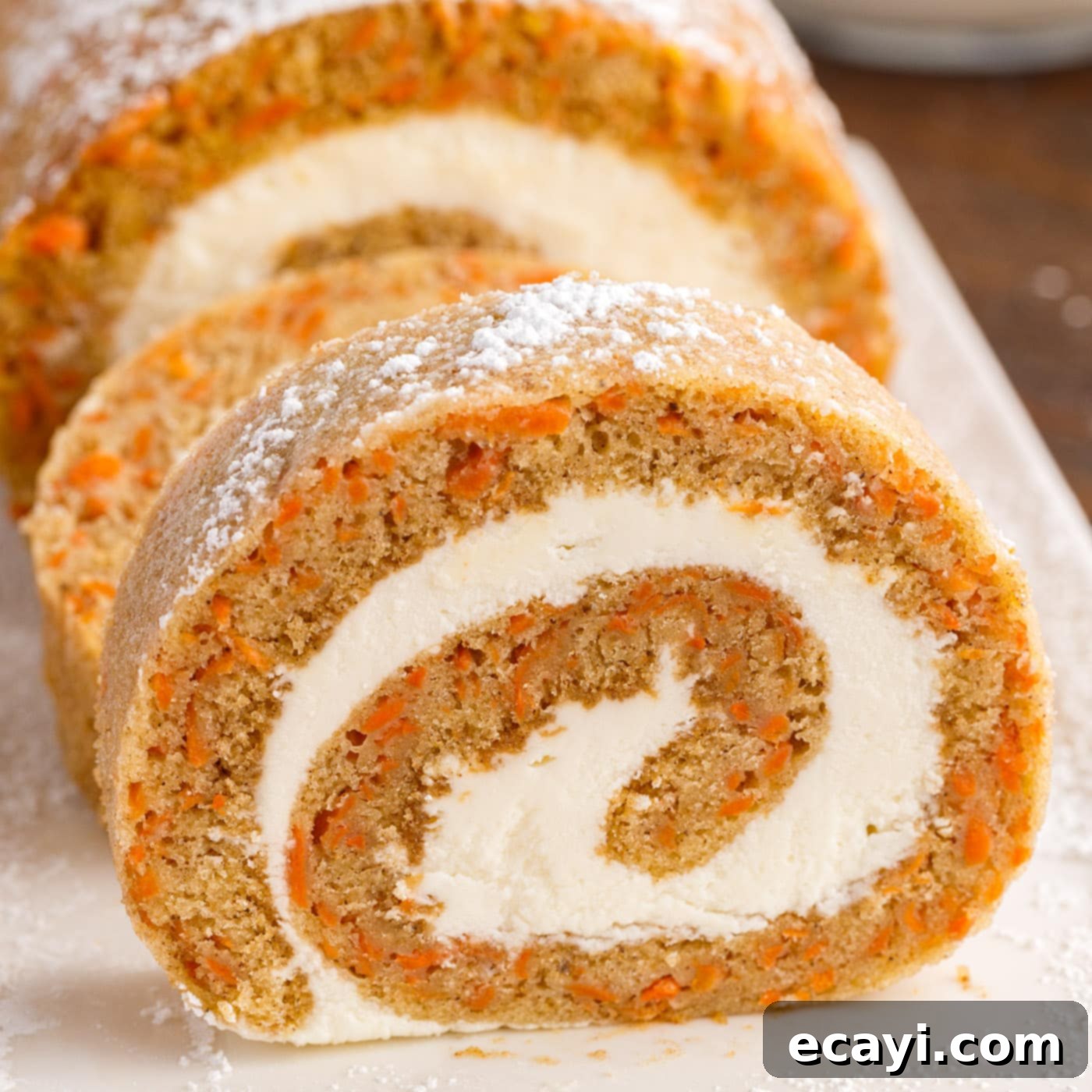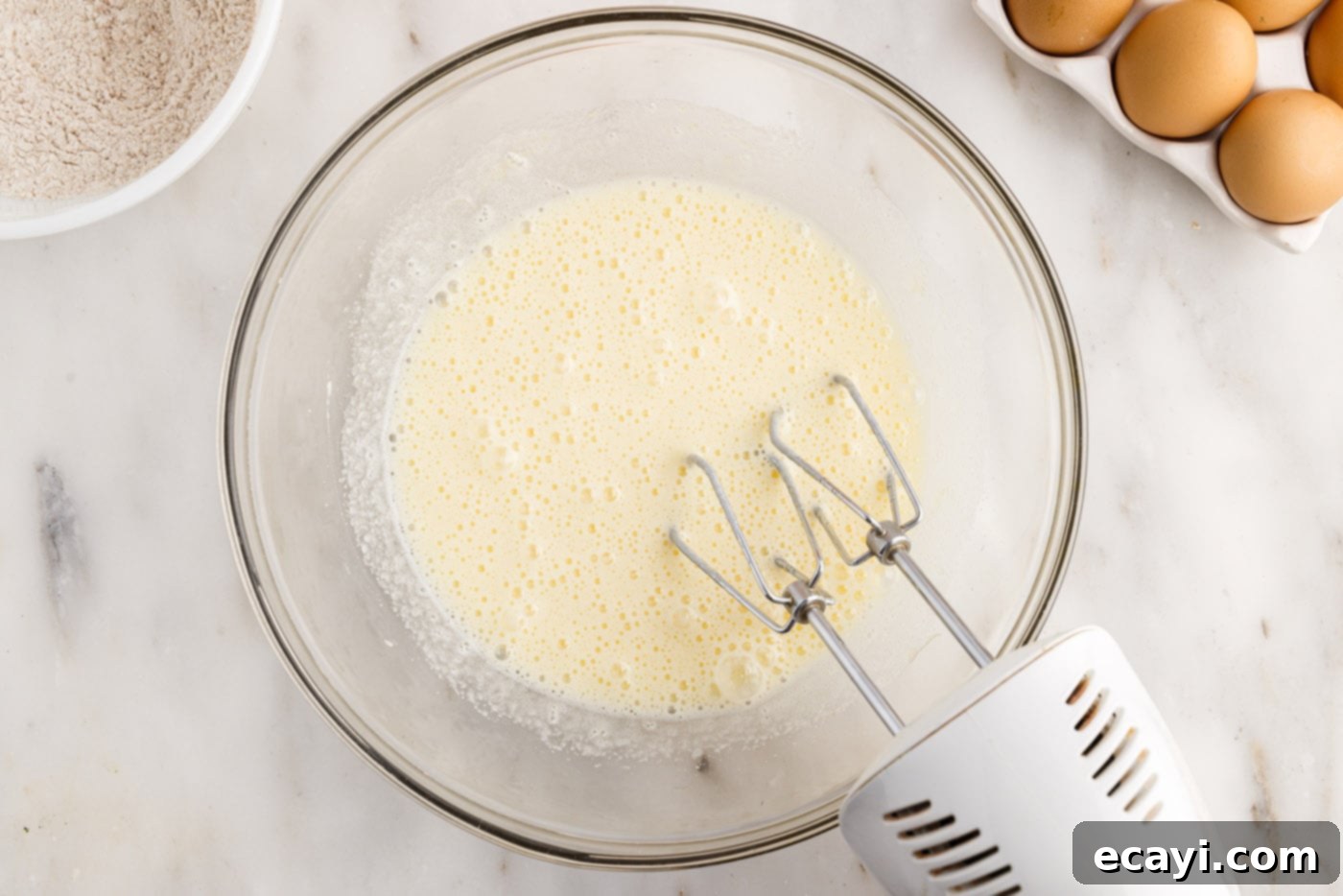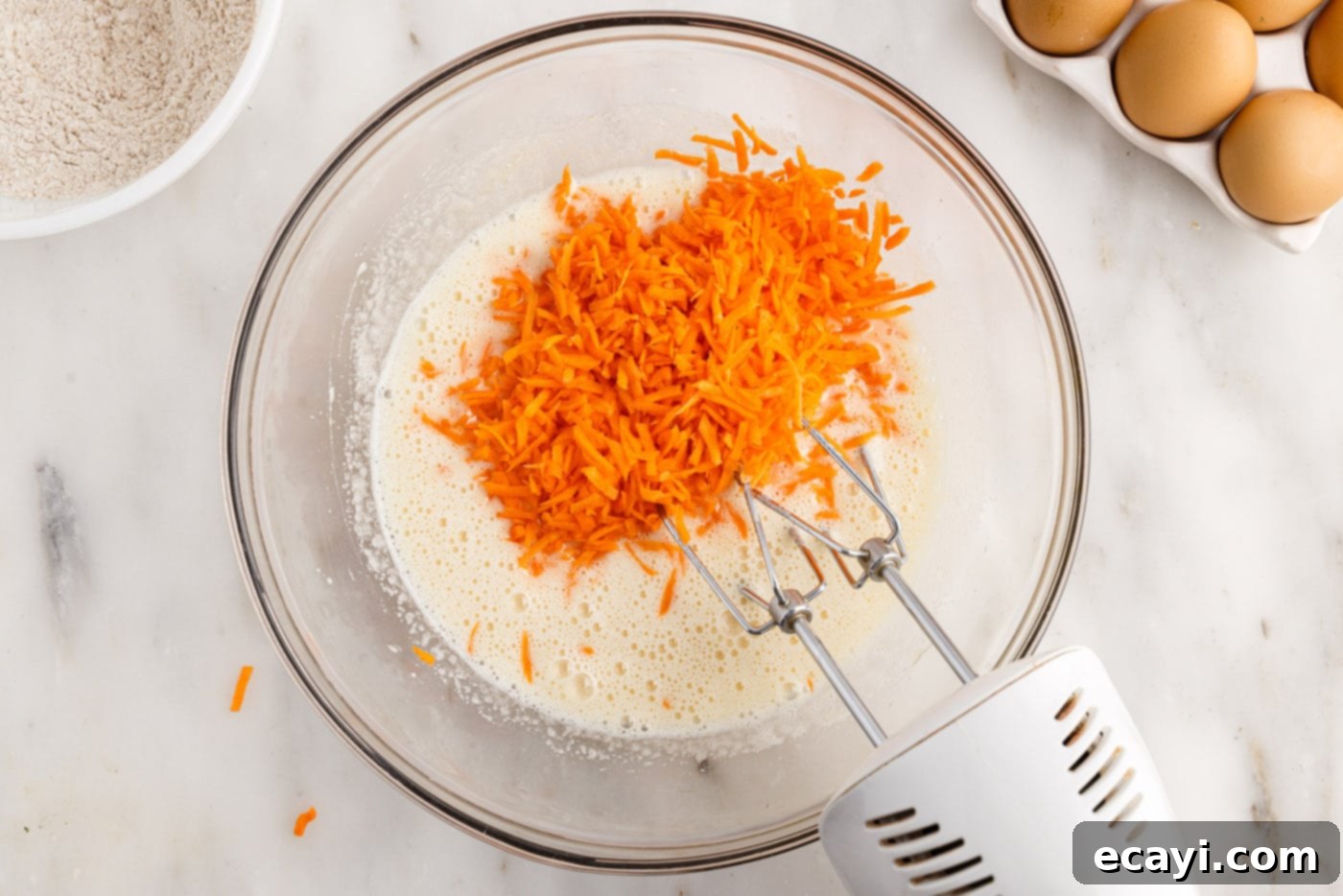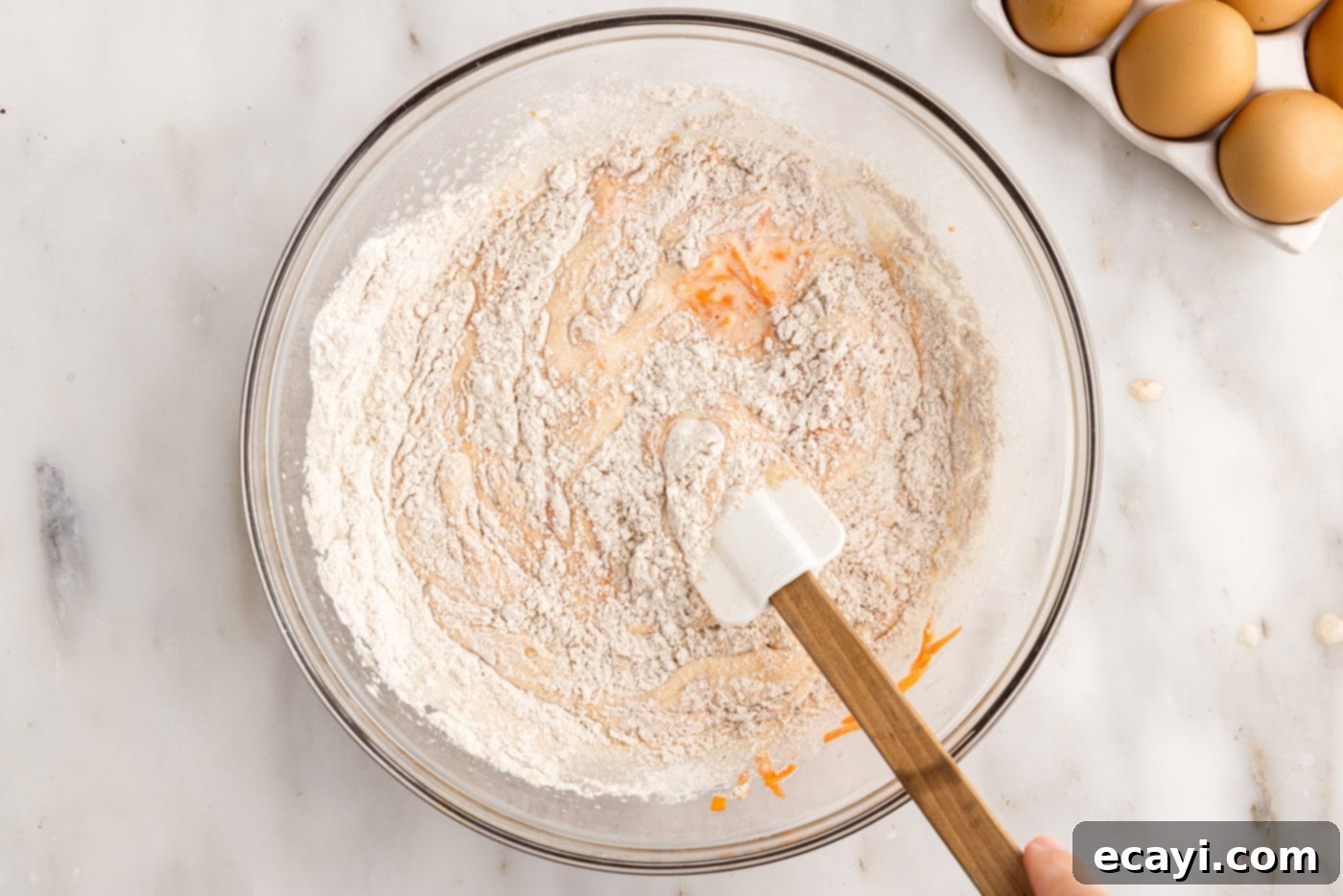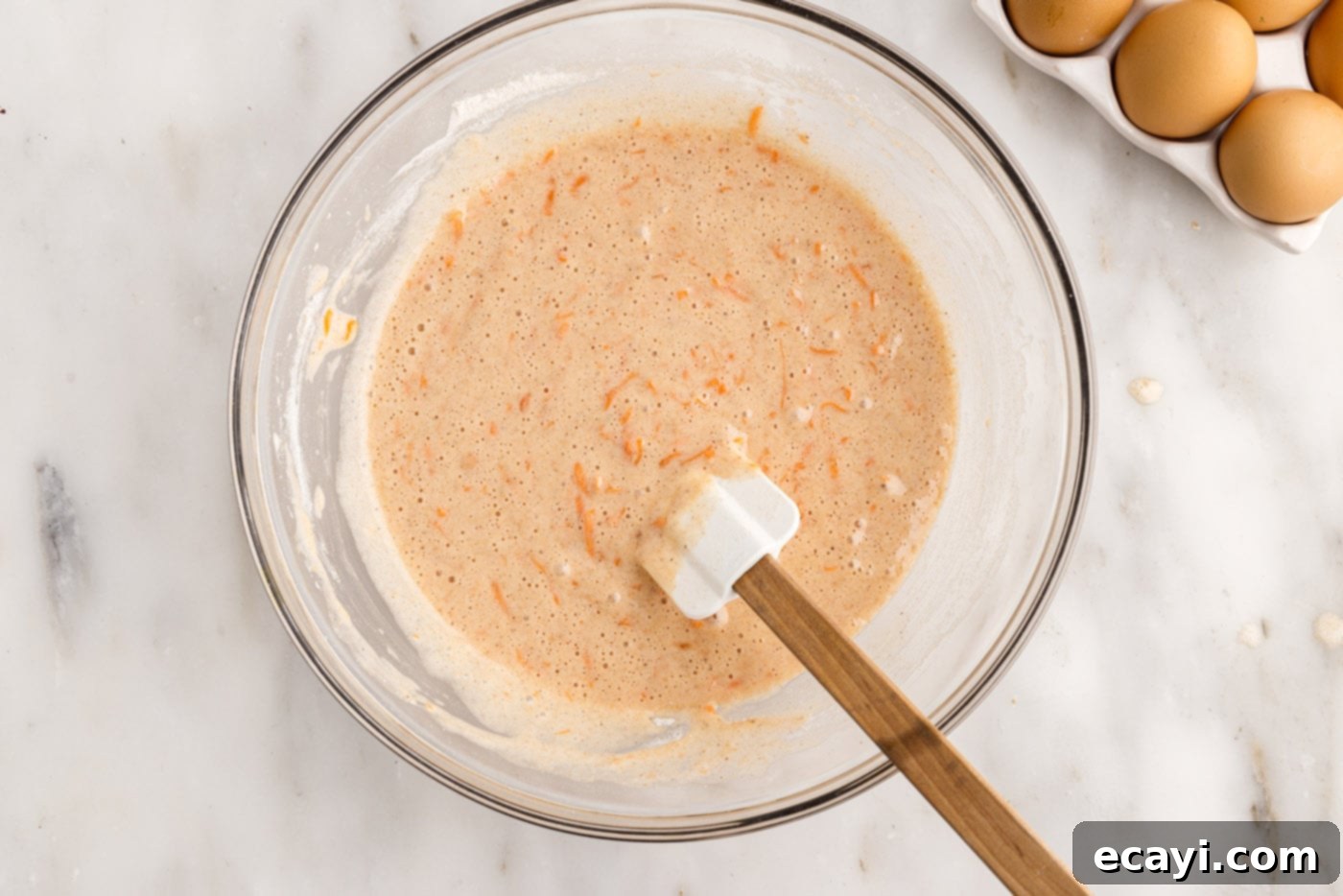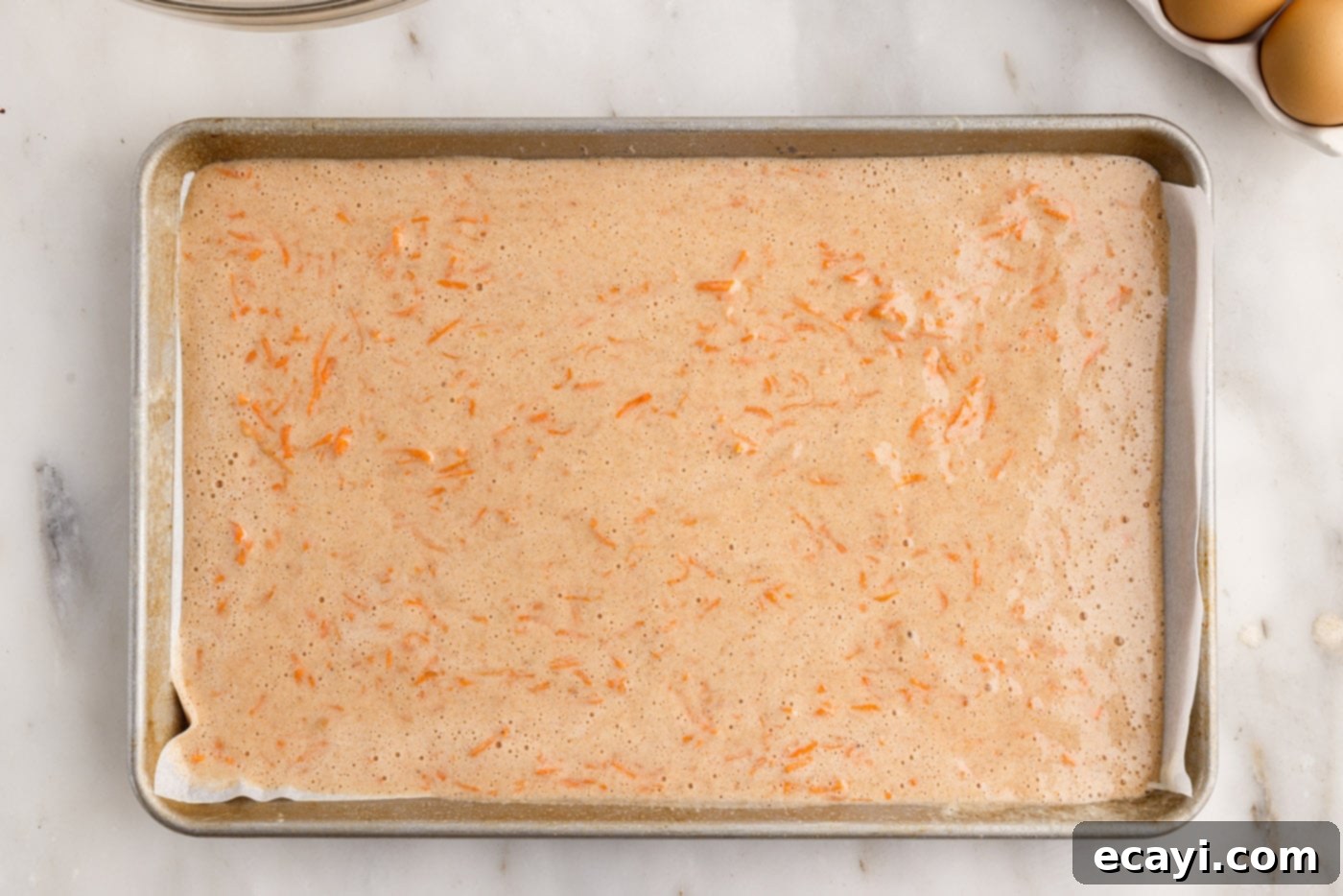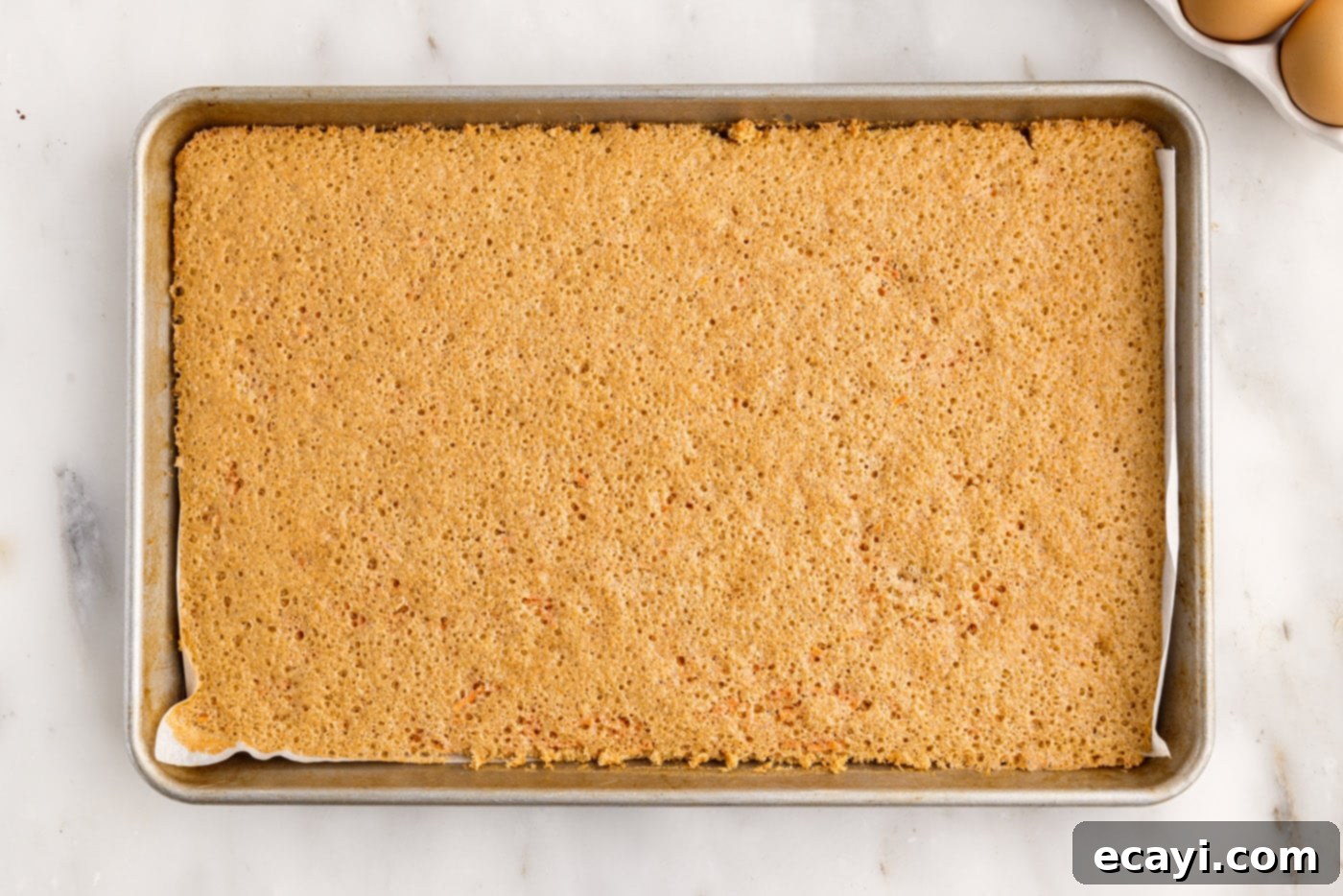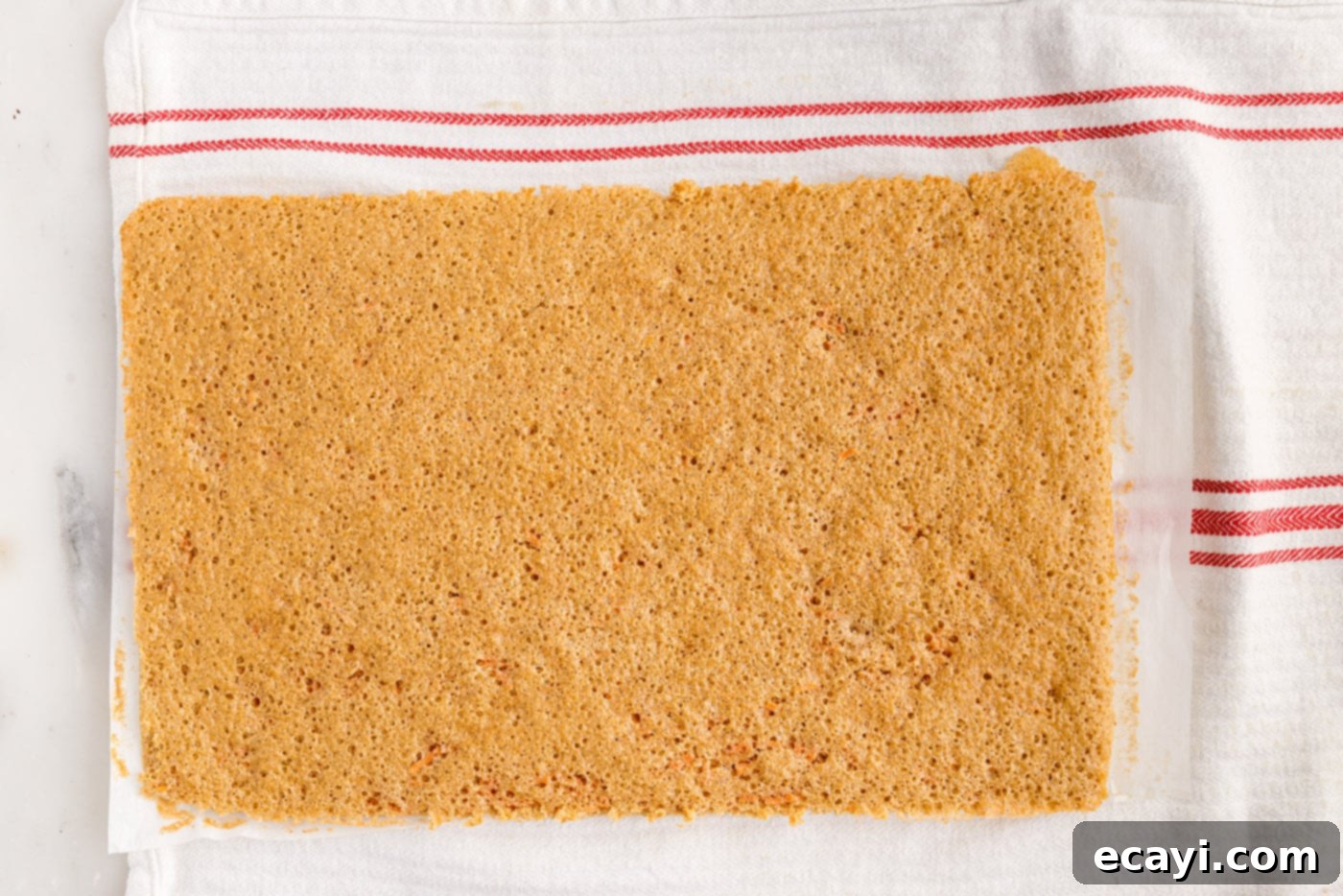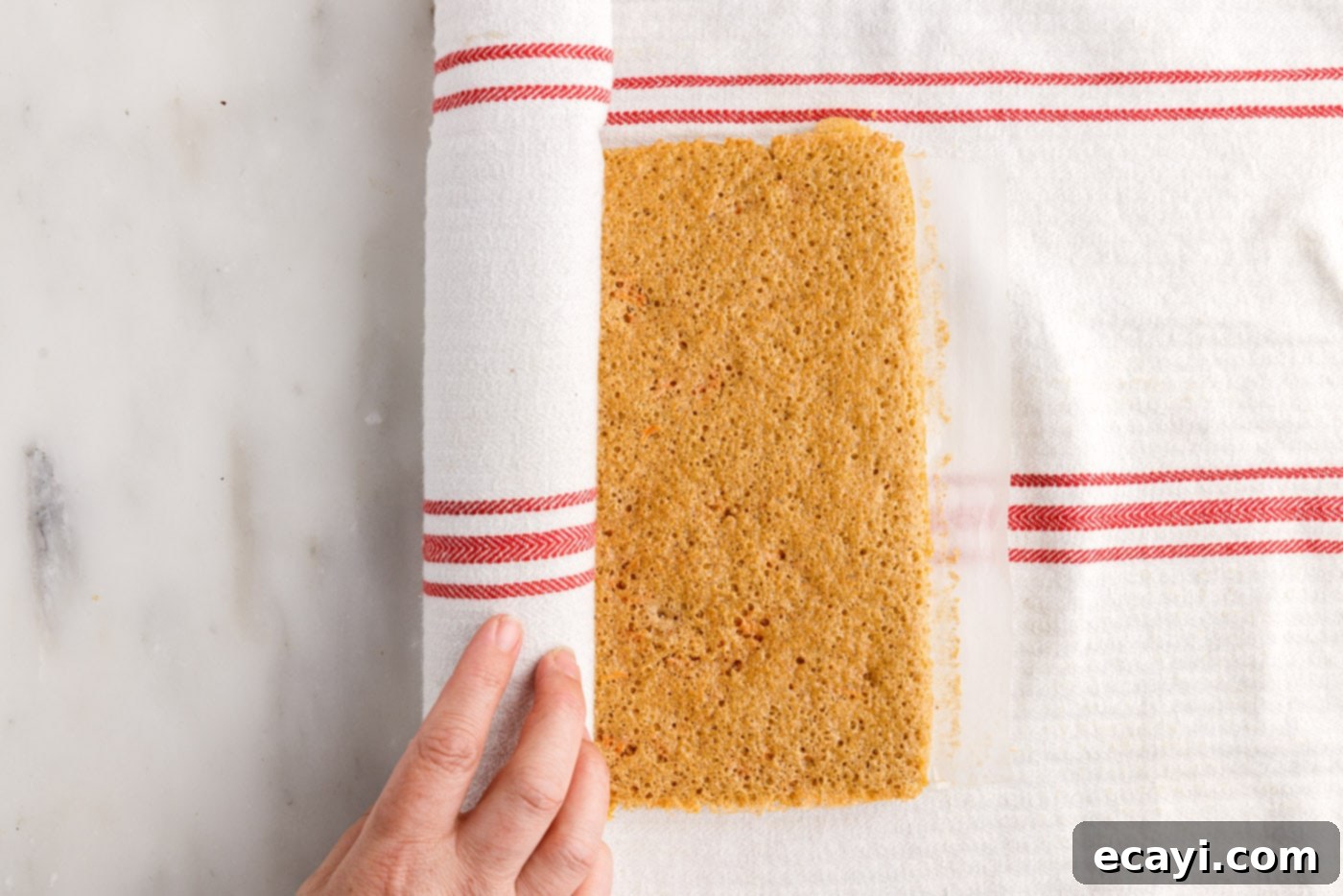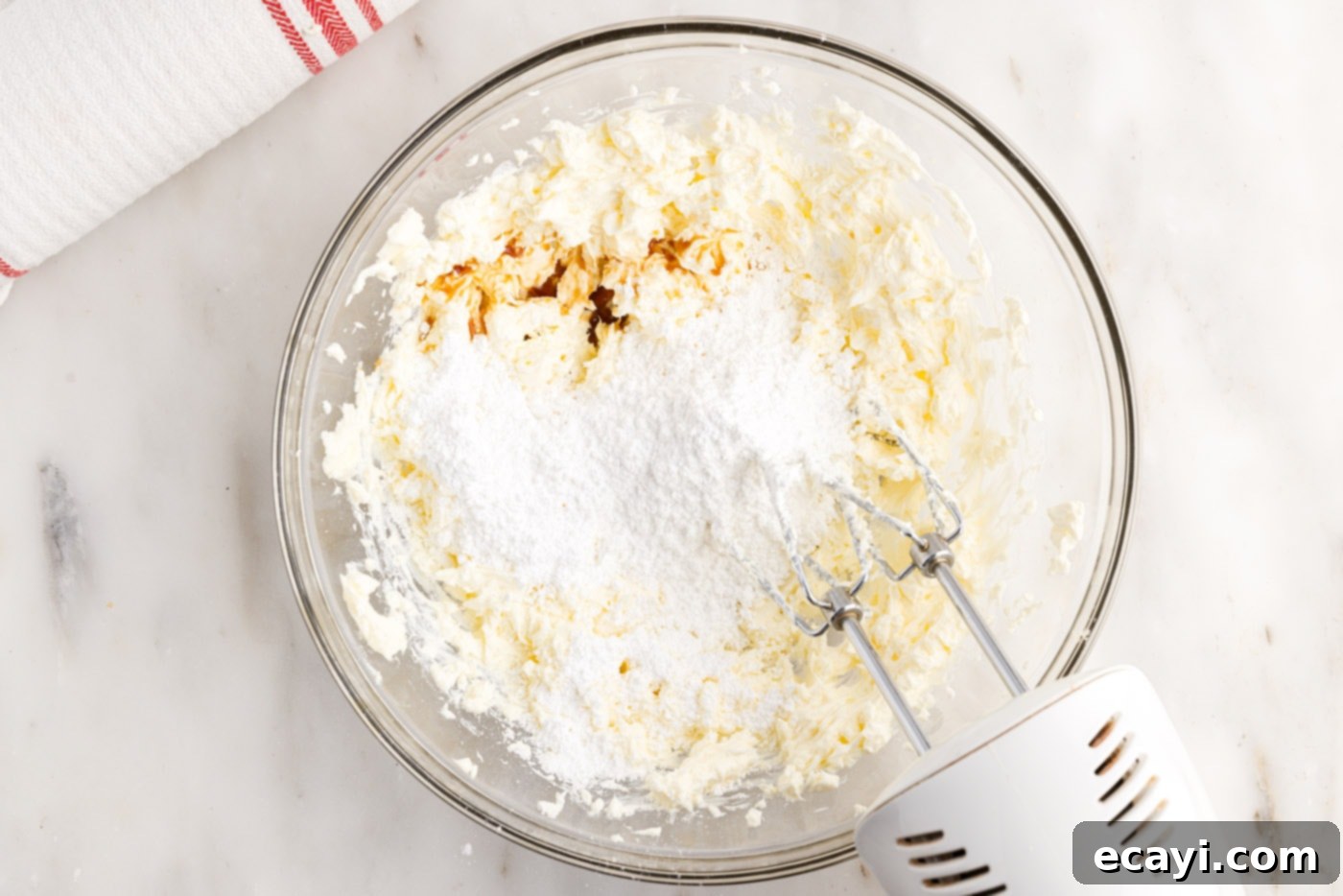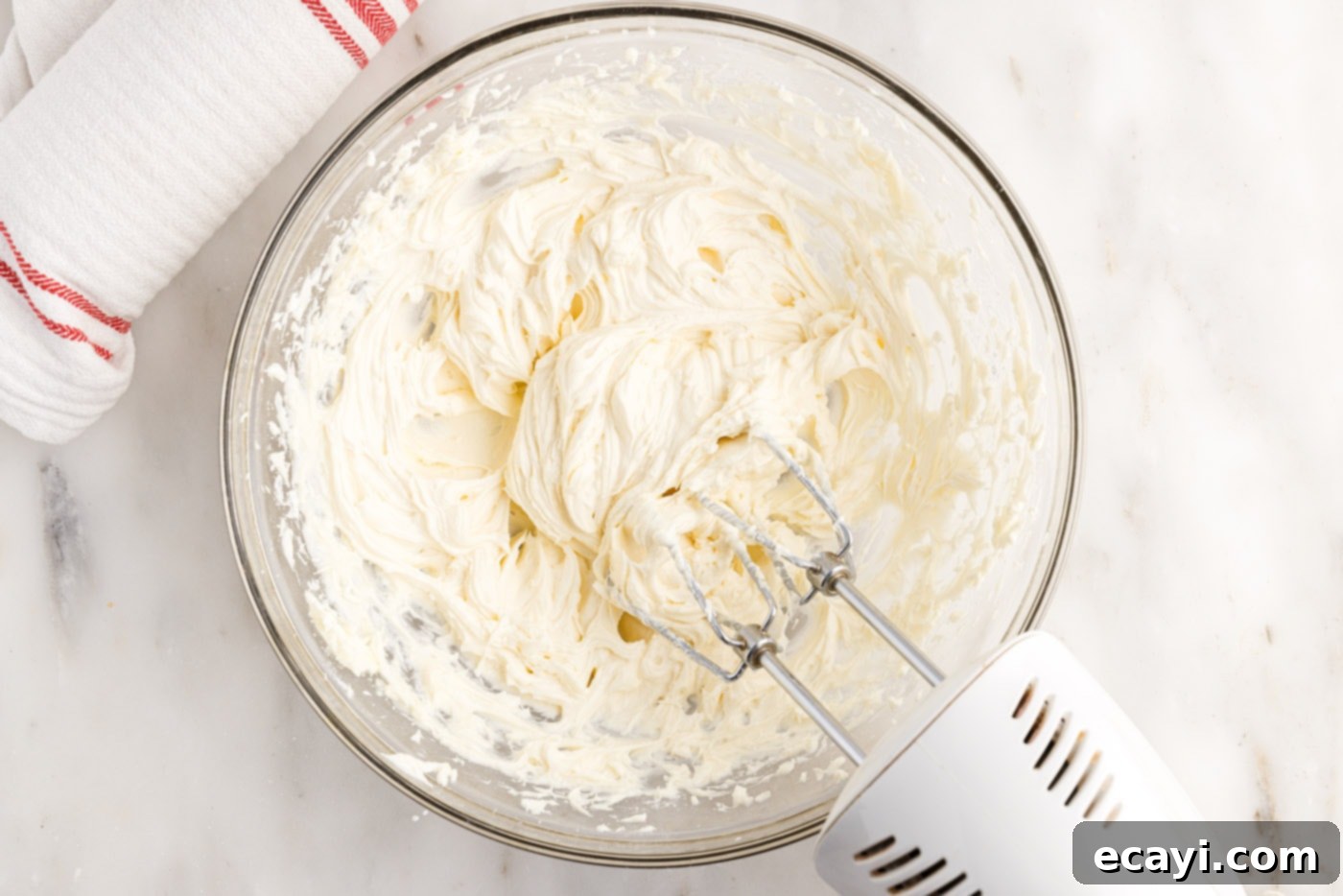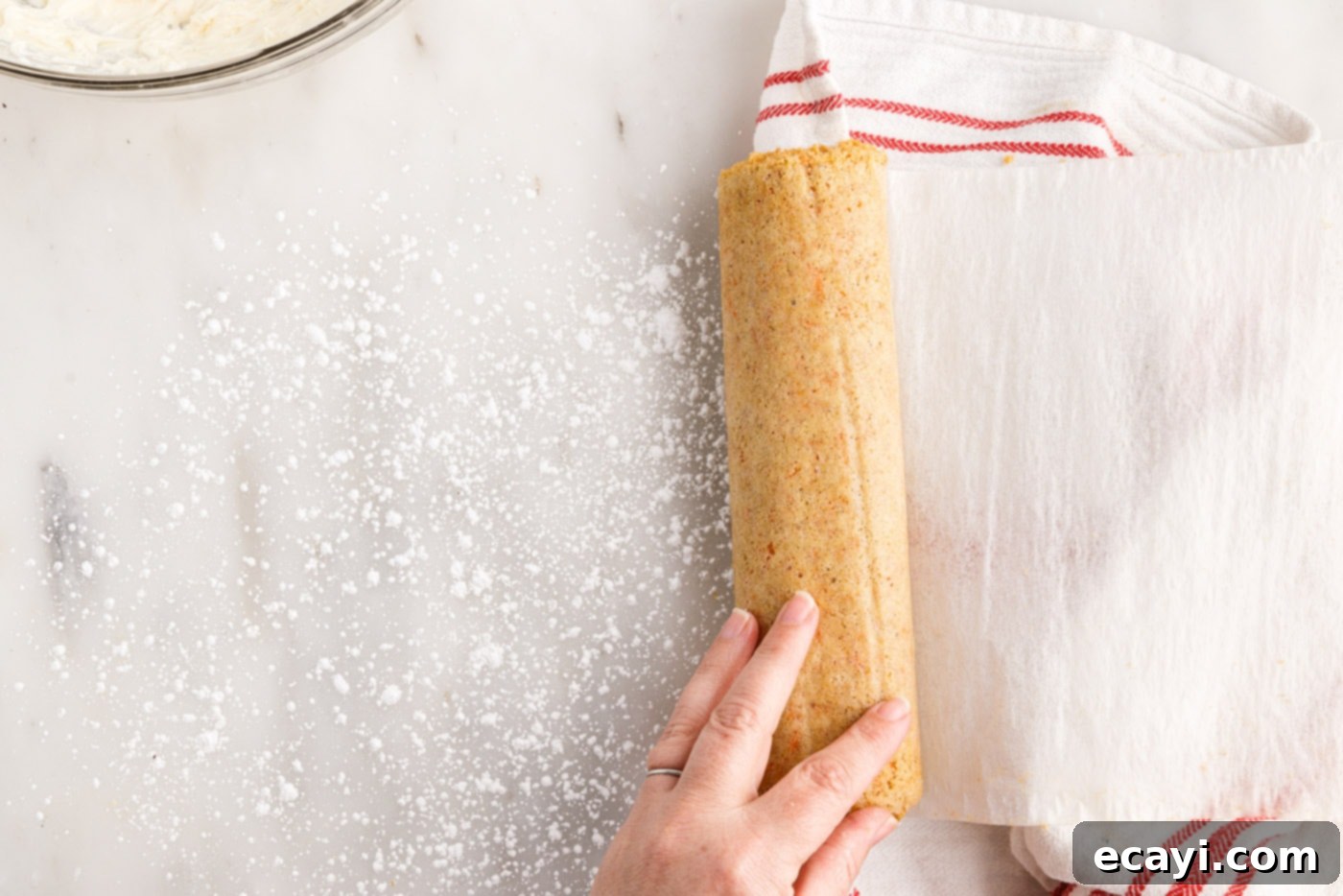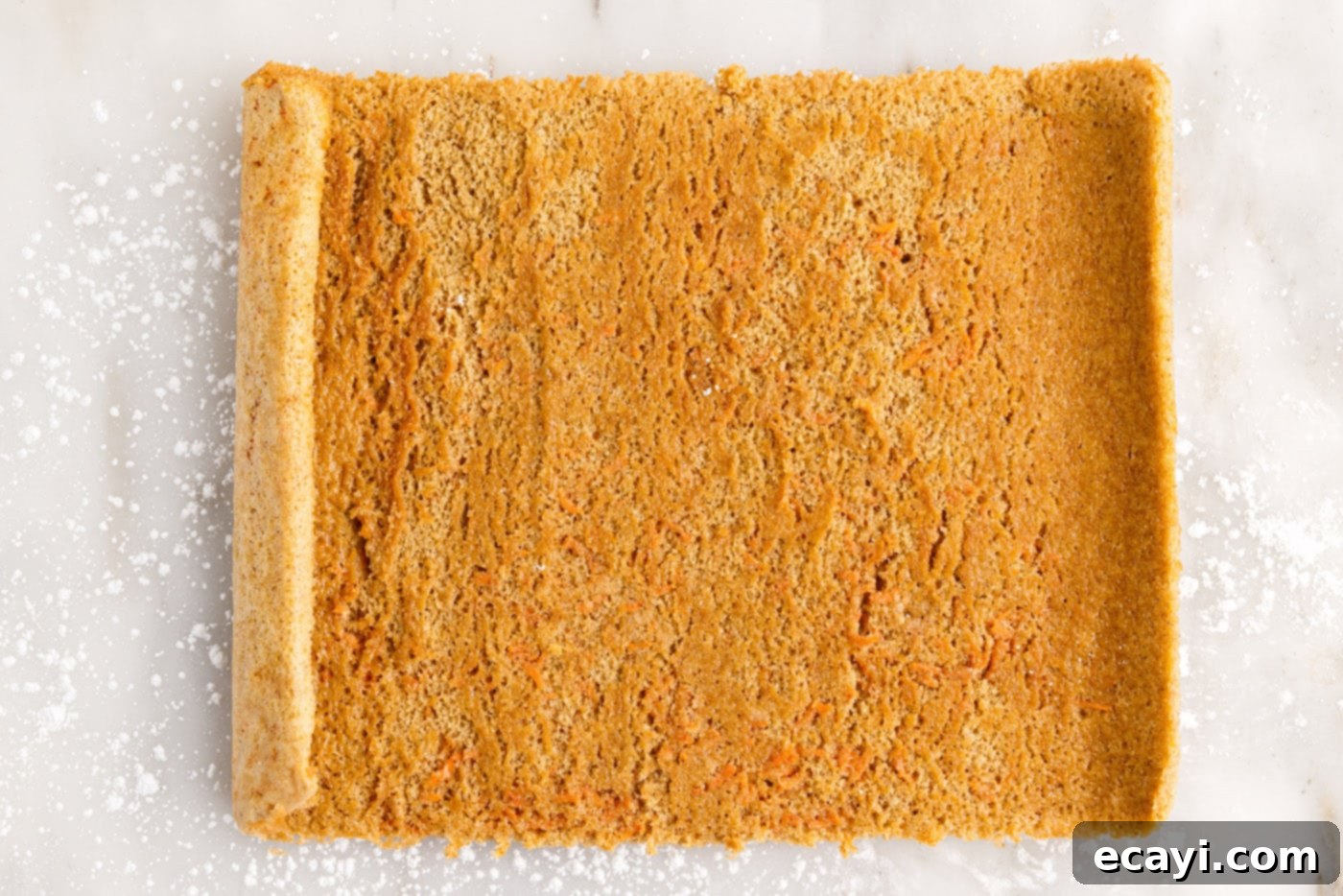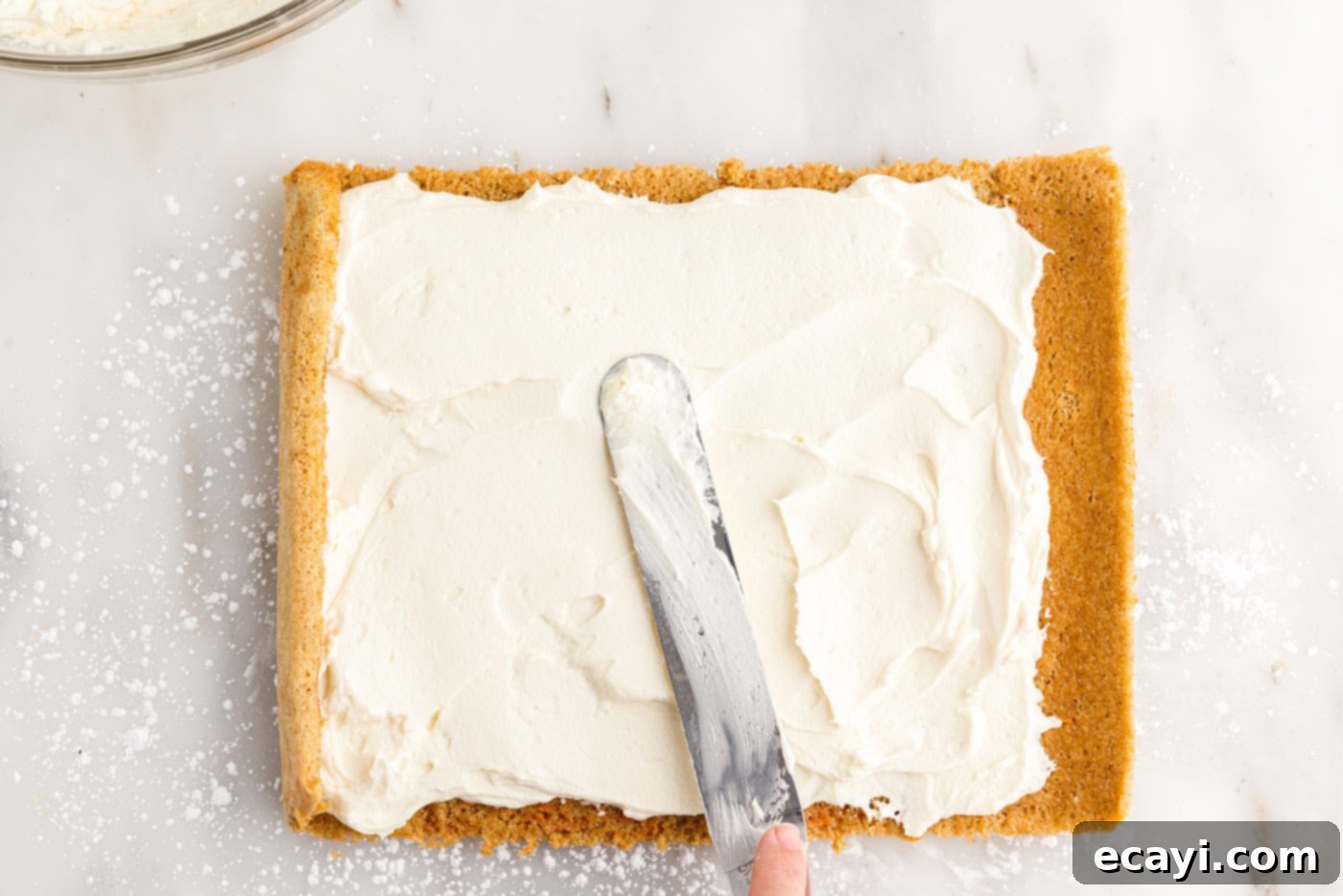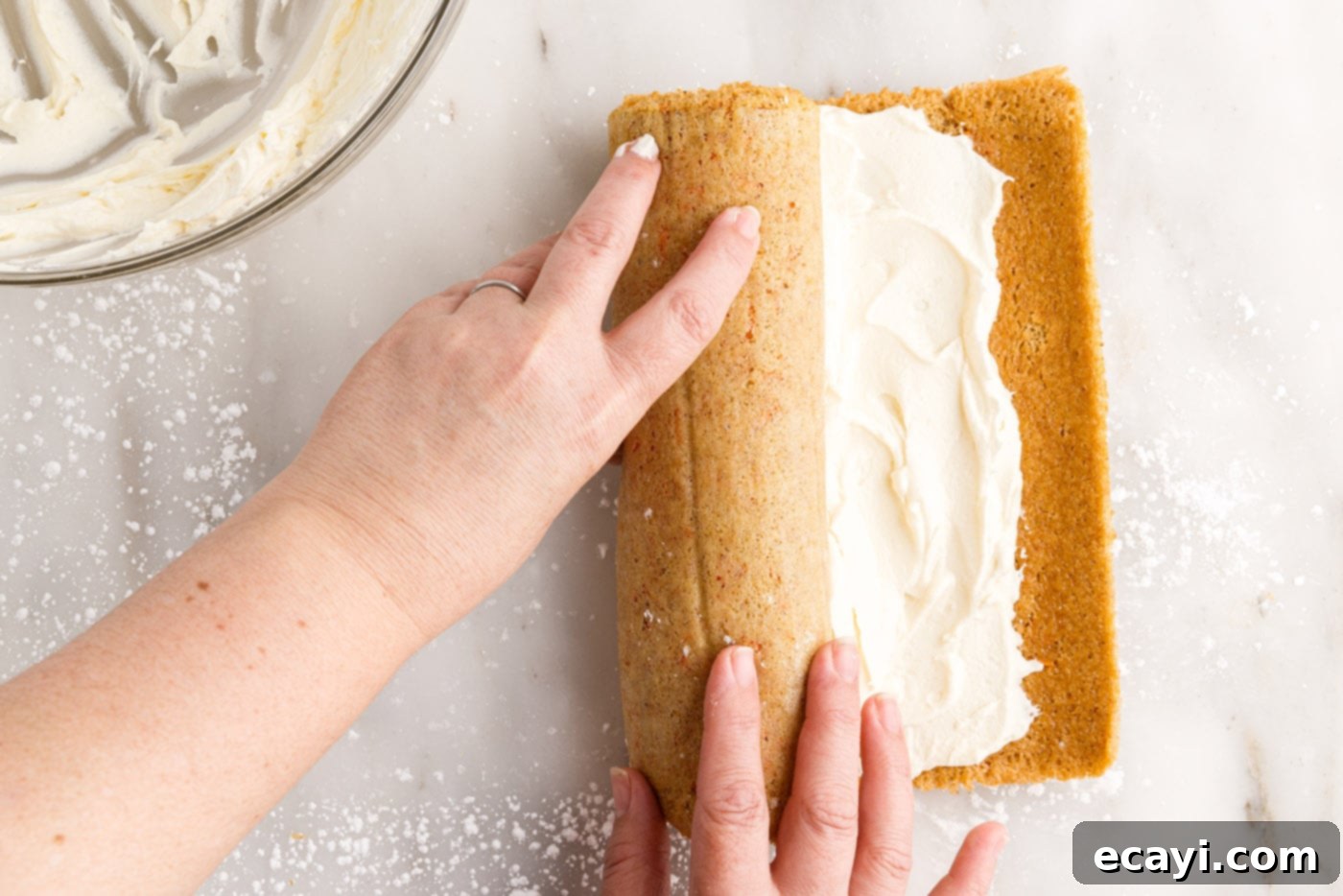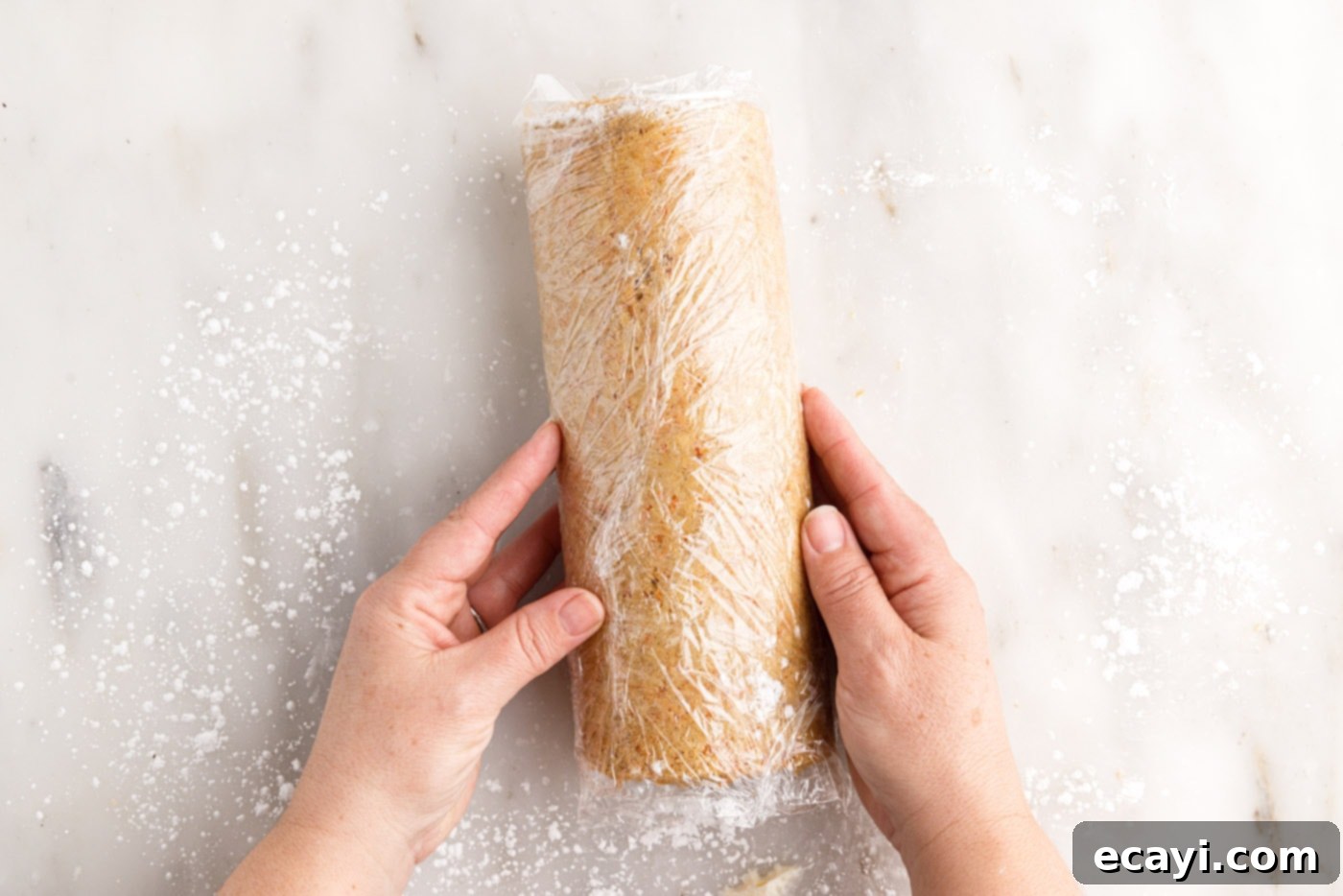Easy Carrot Cake Roll Recipe with Luscious Cream Cheese Frosting
This delightful carrot cake roll is a true showstopper, offering a perfect blend of spongy texture and warmly spiced flavors. Each slice reveals a beautiful swirl of finely grated carrots within the moist cake, generously layered with a rich, tangy cream cheese filling. It’s an ideal spring dessert, fantastic for Easter celebrations, or any occasion where you want to impress with a visually stunning and incredibly delicious treat. Forget the fuss of traditional layer cakes; this rolled version is simpler to make and even easier to transport, making it a go-to for potlucks and family gatherings.
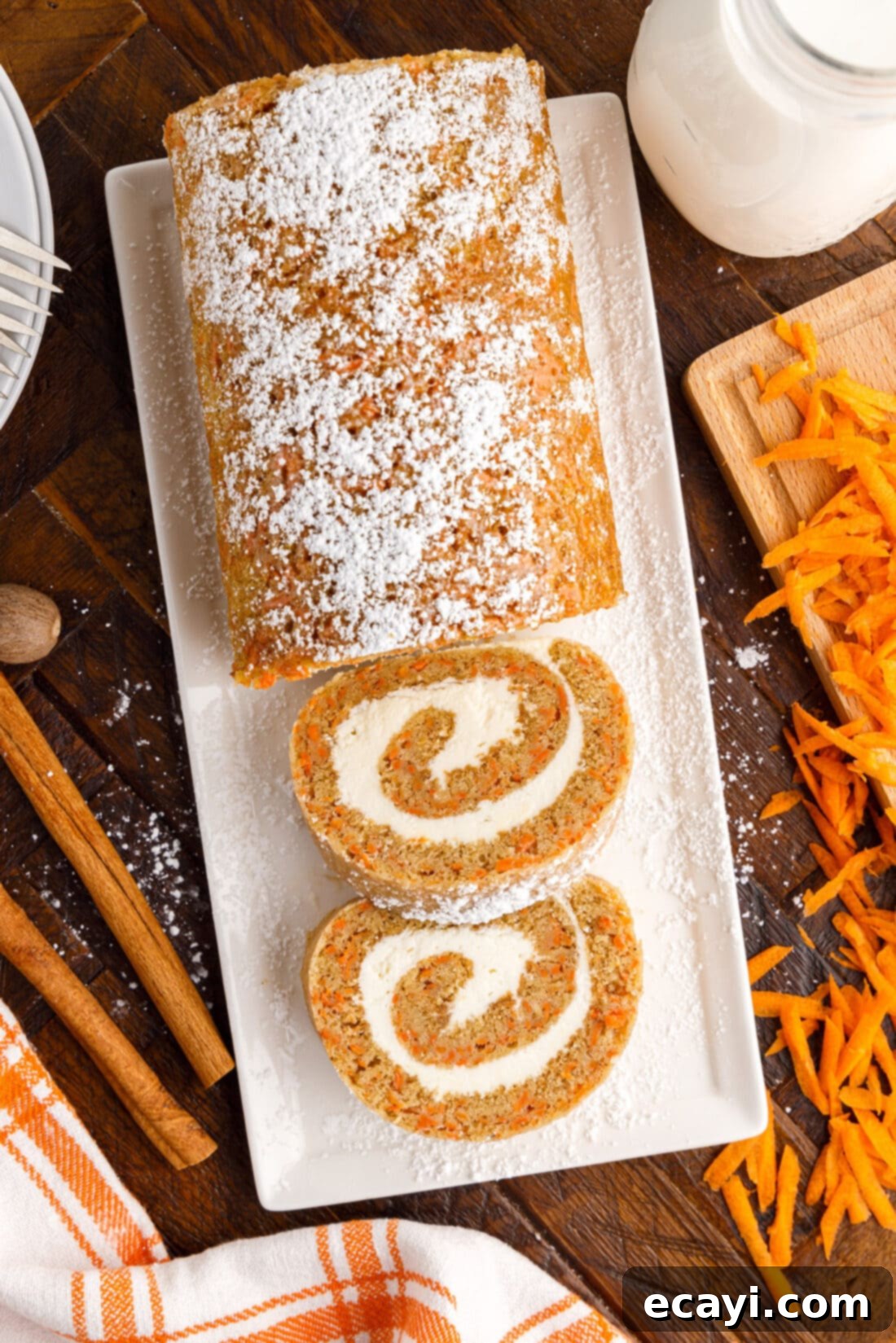
Why This Carrot Cake Roll Recipe Works Wonders
Beyond its striking visual appeal, this carrot cake roll recipe offers all the beloved flavors of a classic carrot cake in a novel, exciting format. The real magic lies in its presentation: a beautiful spiral of moist cake and creamy frosting that’s far simpler to achieve than it looks. This “roll, slice, and serve” dessert is a refreshing twist on traditional baking, making it incredibly popular for special occasions and casual gatherings alike. Unlike a multi-tiered cake, a cake roll is wonderfully portable, stress-free to transport, and serves beautifully, making it an excellent choice for holidays like Easter, or even a pumpkin roll for Thanksgiving, or a versatile Swiss roll for any time of year. While it may require a little more initial prep than a simple rectangular sheet cake, the stunning swirled interior and delectable taste are well worth the minor extra effort.
The success of a cake roll hinges on the cake’s texture. This recipe specifically crafts a cake that is light, moist, and incredibly pliable – much like a chiffon cake. The inclusion of vegetable oil, rather than butter, along with the natural moisture from the grated carrots, ensures the cake remains flexible and won’t crack when rolled. This unique characteristic is precisely what makes it ideal for achieving that signature spiral design without any frustration. The aromatic spices—cinnamon, ginger, nutmeg, and cloves—are perfectly balanced, infusing every bite with that comforting, familiar carrot cake flavor that everyone adores. Paired with the silky-smooth cream cheese frosting, it creates a harmonious balance of sweet, spicy, and tangy notes that are truly irresistible.
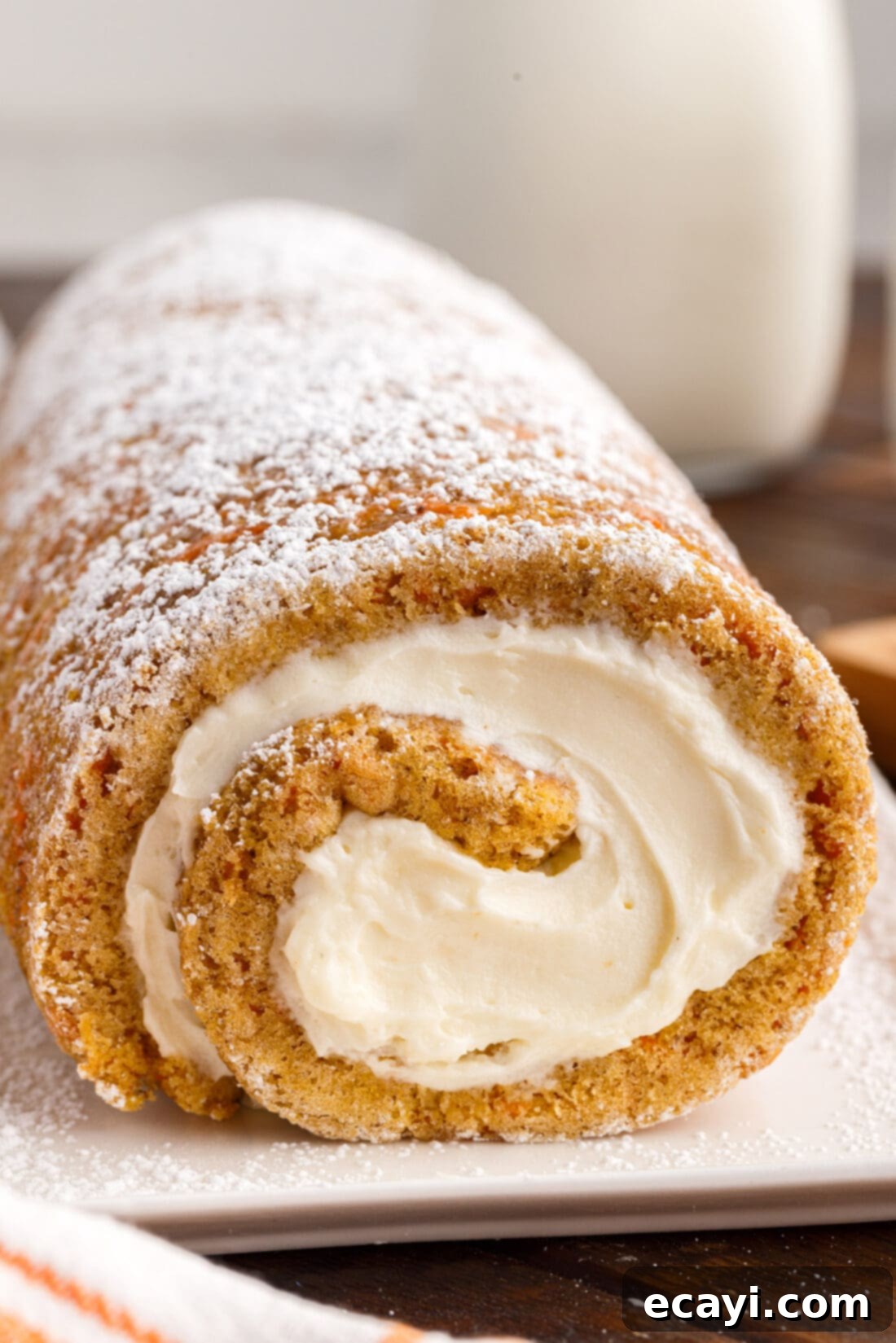
Essential Ingredients for Your Carrot Cake Roll
To create this delightful carrot cake roll, you’ll need a selection of fresh and pantry staples. For exact measurements, detailed instructions, and a printable version of this recipe, please refer to the complete recipe card at the end of this post. Having all your ingredients prepped and at room temperature (especially eggs, butter, and cream cheese) will ensure a smooth baking and frosting process, leading to the best possible results.
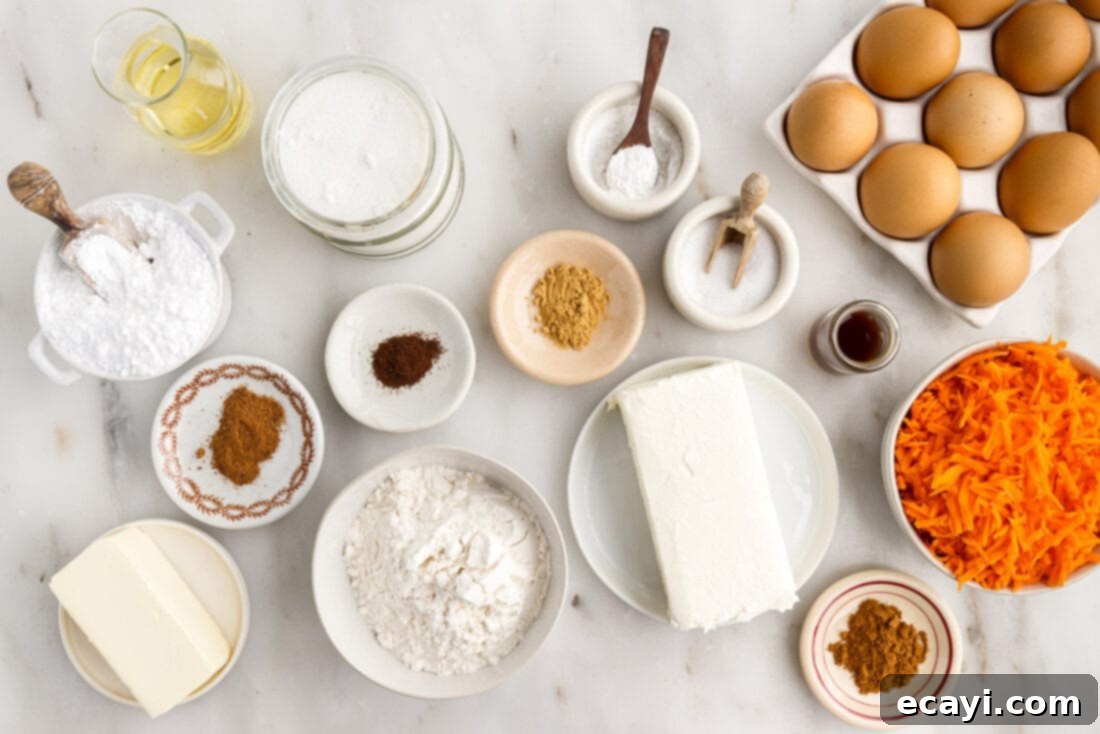
Ingredient Insights and Substitution Suggestions
Understanding the role of each ingredient is key to successful baking. Here’s a closer look at the stars of our carrot cake roll:
CARROTS: The Heart of the Cake – Freshly grated carrots are non-negotiable for authentic carrot cake flavor and moisture. After washing and peeling, grate your carrots finely. A box grater works perfectly for this, or for a quicker method, use a food processor fitted with the grater attachment. The key is “finely grated” – this ensures they blend seamlessly into the cake batter without creating large chunks, contributing to a smooth, uniform crumb. The number of carrots you’ll need can vary depending on their size. For reference, we used about 6-8 skinny carrots to yield the required 2 cups for this recipe.
CAKE: Soft, Moist, and Flexible – The cake itself is designed to be wonderfully light and moist, reminiscent of a delicate chiffon cake. This specific texture is crucial for a cake roll. The vegetable oil plays a vital role in providing a deep, consistent moisture that keeps the cake soft and malleable. Unlike butter, which can make cakes denser and more prone to cracking when cooled, oil ensures the cake remains flexible enough to roll without breaking. This pliability is exactly what you need to achieve that flawless spiral design without any cracks, making the rolling process much easier and more forgiving.
SPICES: The Aromatic Foundation – The classic warm spices are what give carrot cake its signature comforting aroma and flavor.
- Cinnamon: Provides a sweet, woody warmth that is fundamental to carrot cake.
- Ginger: Adds a subtle peppery, citrusy kick that brightens the flavor profile.
- Nutmeg: Offers a sweet, slightly nutty, and spicy undertone, enhancing the overall depth.
- Cloves: A powerful, aromatic spice that brings a warm, sweet, and pungent note, complementing the other spices beautifully.
These spices collectively create that unmistakable, inviting fragrance and taste that makes carrot cake so universally loved. Ensure your spices are fresh for the most vibrant flavor.
CREAM CHEESE FILLING: The Perfect Companion – The rich, tangy cream cheese filling is the indispensable partner to the sweet, spiced cake.
- Unsalted Butter (softened): Provides richness and structure to the frosting. Make sure it’s truly softened (but not melted) for a smooth consistency.
- Cream Cheese (softened): The star of the frosting, adding its signature tangy flavor and creamy texture. Like butter, room temperature is crucial for a lump-free frosting.
- Powdered Sugar: Sweetens the frosting and helps create its smooth, fluffy texture. Sifting it can prevent lumps.
- Vanilla Extract: Enhances the sweetness and depth of flavor in the frosting.
The contrast between the sweet cake and the slightly tart cream cheese frosting is what truly elevates this dessert.
How to Make the Perfect Carrot Cake Roll
These step-by-step photos and detailed instructions are provided to help you visualize each stage of making this delicious recipe. For a concise, printable version of this recipe, complete with precise measurements and instructions, you can Jump to Recipe at the bottom of this post.
- Begin by preheating your oven to a precise 375°F (190°C). This ensures the oven is at the correct temperature when the cake goes in, promoting even baking. Prepare a jelly roll pan (typically 10×15 inches) by lining it with parchment paper. This step is crucial for easy removal of the baked cake. Once lined, lightly spray the parchment paper with a nonstick baking spray to prevent any sticking. Set the prepared pan aside.
- In a small mixing bowl, combine all your dry cake ingredients: flour, baking powder, ground cinnamon, ground ginger, ground nutmeg, ground cloves, and salt. Whisk these together thoroughly to ensure the leavening agents and spices are evenly distributed throughout the flour. This prevents pockets of unmixed ingredients and guarantees a consistent flavor and texture in the finished cake. Set this bowl aside for later use.
- Now, in a larger separate bowl, using either a standing mixer fitted with the whisk attachment or an electric hand mixer, beat the room-temperature eggs and granulated sugar together. Beat them on medium-high speed for 3-5 minutes, or until the mixture becomes pale in color, thick, and wonderfully foamy. This process incorporates air into the eggs, which is vital for creating a light and airy cake texture that will be flexible enough to roll without cracking.

Beating eggs and sugar to achieve the perfect light and airy base for the cake. - Reduce the mixer speed to low, or remove the bowl and stir by hand. Carefully mix in the vanilla extract, vegetable oil, and the finely grated carrots. Continue mixing until all these wet ingredients are just combined. Be careful not to overmix at this stage; you want to maintain the air incorporated into the eggs.

Incorporating the moisture-rich carrots and flavorings into the wet batter. - With a rubber spatula, gently fold the previously prepared dry flour mixture into the wet ingredients. Do this in two or three additions, folding until just combined. Overmixing can lead to a tough cake, so stop as soon as no streaks of flour remain. The batter will be relatively thin, which is normal for a roll cake.

Gently folding in the dry ingredients to maintain a light texture. 
The perfectly mixed batter, showcasing a smooth and consistent texture. - Carefully spread the prepared carrot cake batter evenly into the lined jelly roll pan. Ensure the batter reaches all corners of the pan for uniform thickness, which is crucial for even baking and easy rolling.

Spreading the batter thinly and evenly for optimal rolling. - Bake in the preheated oven for approximately 15 minutes. The cake is done when it’s lightly golden brown across the top, springs back gently when lightly touched, and a wooden skewer or toothpick inserted into the center comes out clean. Do not overbake, as this can dry out the cake and make it prone to cracking during rolling.

The beautifully baked cake, perfectly golden and ready for the next step. - Once baked, promptly remove the cake from the oven. Allow it to cool in the pan for just 3-5 minutes. This brief cooling period helps the cake firm up slightly before you attempt to roll it.
- While the cake is still warm, lay out a clean linen kitchen towel (a tea towel works well) on a flat surface. Lightly dust the towel generously with powdered sugar. This prevents the warm cake from sticking to the towel. Carefully lift the cake, along with its parchment paper, from the pan and invert it onto the prepared linen towel. Peel off the parchment paper that was on the bottom of the cake. Align one short edge of the cake with the side edge of the linen. From this short end, begin to roll the cake snugly, along with the towel, into a tight log. This initial roll, while the cake is warm and pliable, trains it to hold its spiral shape. Dusting the top of the cake with a little more powdered sugar before rolling can further prevent sticking to the linen. Place the rolled cake, seam-side down, on a wire cooling rack and allow it to cool completely to room temperature, which typically takes about 30 minutes to 1 hour. It’s crucial for the cake to be completely cool before unrolling and frosting, as warm cake will melt the cream cheese filling. (*See notes below and in the recipe card for alternative rolling methods.)

Preparing the cake for its initial roll to set its spiral shape. 
The crucial first roll, forming the cake’s iconic spiral structure. - While the cake is cooling, prepare the luxurious cream cheese filling. In a medium mixing bowl, beat together the softened unsalted butter and softened cream cheese until the mixture is beautifully creamy and smooth. This typically takes 2-3 minutes on medium speed. Next, add the vanilla extract and gradually incorporate the powdered sugar, beating for another 2-3 minutes until the filling is smooth, light, and wonderfully fluffy. Be careful not to overbeat, as this can make the frosting too thin.

Combining ingredients for the smooth and flavorful cream cheese filling. 
The perfectly whipped cream cheese frosting, ready for spreading. - Once the cake has completely cooled to room temperature, gently unroll it onto a surface that has been lightly dusted with powdered sugar. If you initially rolled it with the parchment paper still attached (see notes), carefully peel the parchment paper off the cake as you unroll it. You’ll notice that the two short ends of the cake will likely remain slightly curled; this is perfectly normal and it’s best to leave them as they are, as they will help contain the filling.

Carefully unrolling the cake, revealing its smooth, uncracked surface. 
The unrolled cake, showing its readiness for the creamy filling. - Evenly spread the prepared cream cheese filling over the entire surface of the unrolled cake. Make sure to leave a clear border of about an inch (2.5 cm) uncovered along one of the short edges (the one that will be the “outer” edge when re-rolled). This margin is important because as you re-roll the cake, the filling will naturally squish and spread to fill this empty space, preventing it from oozing out excessively.

Applying the luscious cream cheese frosting, leaving a border for a clean roll. - Starting from the short edge where the frosting begins (the opposite end from the inch you left unfrosted), begin to re-roll the cake. Tuck the edge in tightly and then roll it as snugly as you can. As you roll, be mindful to maintain that beautiful, even layer of cream cheese filling on the inside, ensuring a perfect spiral. The flexibility of the cake should make this step straightforward.

The art of re-rolling, creating the signature swirled pattern with the frosting. - Once fully re-rolled, carefully transfer the cake log to a sheet of plastic wrap. Wrap it securely with plastic wrap, ensuring it holds its perfectly round shape and the filling is sealed in. Place the wrapped cake log in the refrigerator (or freezer for a quicker chill) for at least one hour, or preferably two, seam side down. This chilling period is essential; it allows the cake to firm up completely and the cream cheese filling to set, making for much cleaner and easier slicing later on.

Chilling the cake roll to ensure a firm set and perfect slices. - When you are ready to serve this delicious dessert, remove the chilled cake roll from the refrigerator. Unwrap it from the plastic wrap. For an extra touch of elegance and flavor, lightly dust the entire top surface of the cake roll with additional powdered sugar. Using a sharp, thin knife, slice the log into approximately 1-inch (2.5 cm) thick pieces. Wiping the knife clean between each slice will help achieve the neatest possible cuts, showcasing that beautiful spiral design. Enjoy your homemade carrot cake roll!
Frequently Asked Questions & Expert Tips for Carrot Cake Roll
Absolutely! Adding nuts is a fantastic way to introduce extra texture and flavor. You can either fold about ½ cup of finely chopped pecans or walnuts directly into the cake batter along with the carrots, or, for a more pronounced nutty crunch, sprinkle them generously over the cream cheese frosting before you re-roll the cake. Both methods yield delicious results, so choose the one you prefer!
Proper storage is key to keeping your carrot cake roll fresh and delicious. Whether your cake roll is whole or already sliced, it should always be stored in the refrigerator due to the cream cheese frosting. Place it in an airtight container or wrap it tightly with plastic wrap to prevent it from drying out. Stored this way, it will remain fresh and delightful for 5-6 days. For best flavor and texture, allow slices to come closer to room temperature for about 15-20 minutes before serving.
Yes, carrot cake rolls freeze exceptionally well! To freeze a whole roll, wrap it tightly in several layers of plastic wrap, followed by a layer of aluminum foil. This double-layer protection helps prevent freezer burn. It can be frozen for up to 1 month. When you’re ready to enjoy it, thaw it overnight in the refrigerator, then let it sit at room temperature for about 30 minutes before slicing and serving. You can also freeze individual slices by wrapping each piece in plastic wrap and storing them in a large freezer-safe zip-top bag. This is perfect for portion control and having a quick treat on hand!
While this recipe is designed for flexibility, sometimes cracks can happen. The most common reasons are overbaking (which dries out the cake) or not rolling it while still warm. If your cake does crack during the initial roll, don’t despair! The cream cheese frosting is very forgiving. Simply continue with the rolling process. Once frosted and chilled, the frosting will act as a “glue,” holding the cake together. The cracks will largely disappear or be camouflaged by the swirl, and the flavor will still be amazing!
For both the cake and the frosting, room temperature ingredients (especially eggs, butter, and cream cheese) are crucial for achieving the best texture. Room temperature eggs whip up with more volume, leading to a lighter cake. Softened butter and cream cheese cream together smoothly without lumps, creating a silky-smooth frosting that is easy to spread and integrates beautifully.
Expert Tips for a Flawless Carrot Cake Roll
- Fine Grate is Key: Ensure your carrots are very finely grated. Larger pieces can make the cake heavier and disrupt the smooth texture required for rolling.
- Don’t Overbake: Keep a close eye on the baking time. An overbaked cake will be dry and brittle, making it very difficult to roll without cracking. The cake should be springy to the touch.
- Roll While Warm: The initial roll in the powdered sugar-dusted towel is vital and must be done while the cake is still warm (after a 3-5 minute cooling period out of the oven). This sets the memory of the roll in the cake, preventing cracks later.
- Powdered Sugar for Non-Stick: Don’t skimp on the powdered sugar when dusting your towel. It creates a barrier that prevents the cake from sticking.
- Chill Thoroughly: The final chilling step after the cake is frosted and re-rolled is non-negotiable. It allows the cake to firm up and the frosting to set, making for clean, beautiful slices.
- Use a Sharp Knife: When slicing, use a long, sharp knife and wipe it clean between each cut. This will give you the most aesthetically pleasing slices, showcasing the perfect swirl.
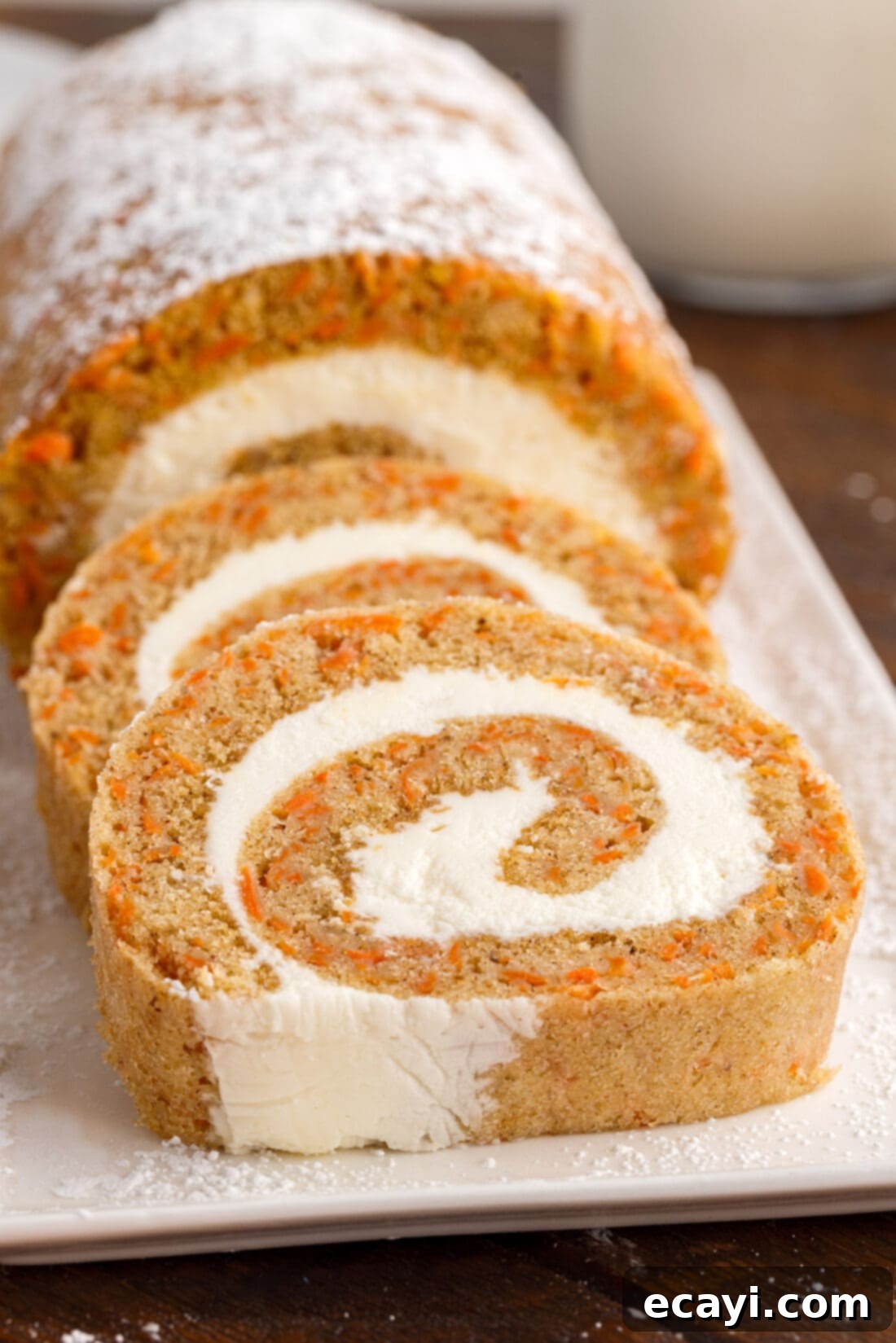
Serving Suggestions for Your Carrot Cake Roll
A beautiful carrot cake roll always feels complete with a delicate dusting of powdered sugar, adding both visual appeal and a subtle sweetness to the exterior, although it’s certainly delicious without it too! For the most elegant presentation and clean cuts, ensure your cake roll is well-chilled before slicing. Once firm, cut the log into approximate 1-inch (2.5 cm) thick slices using a sharp knife. For an extra touch, you can garnish each slice with a tiny sprinkle of extra grated carrot, a pinch of cinnamon, or a small sprig of fresh mint. This dessert pairs wonderfully with a hot cup of coffee, a soothing herbal tea, or as a vibrant, sweet conclusion to any festive meal, especially during spring and Easter celebrations. The contrast of the rich cake and tangy frosting makes it a truly satisfying experience!
Explore More Delectable Carrot Cake Recipes
If you’ve fallen in love with the flavors of carrot cake, there’s a whole world of variations to explore! From breakfast treats to bite-sized delights, these recipes bring the beloved taste of carrot cake to new and exciting forms:
- Carrot Cake Trifle: A stunning layered dessert that combines moist carrot cake pieces with creamy pudding and whipped topping. Perfect for a crowd!
- Carrot Cake Pancakes: Start your day with the comforting flavors of carrot cake in a stack of fluffy pancakes, complete with a cream cheese glaze.
- Carrot Cake Mix Cookies: An incredibly easy and quick way to enjoy carrot cake flavor in chewy, delightful cookies, using a cake mix shortcut.
- Carrot Cake Sandwich Cookies: Soft, spiced carrot cake cookies filled with luscious cream cheese frosting, making for an irresistible hand-held treat.
- Carrot Cake Truffles: Rich, decadent, and perfectly portioned, these truffles are a fantastic no-bake option to satisfy your carrot cake cravings.
I absolutely adore baking and cooking, and there’s nothing I enjoy more than sharing my culinary adventures and perfected recipes with all of you! It can be a challenge to remember to check back every day for new ideas, which is why I’ve made it easy for you with a convenient newsletter. Each time a new, delicious recipe is posted, it lands directly in your inbox. Simply subscribe today and start receiving your free daily recipes, ensuring you never miss out on a tasty creation!
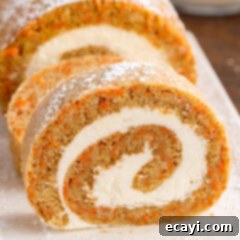
Carrot Cake Roll
IMPORTANT – There are often Frequently Asked Questions and Expert Tips within the blog post that you may find helpful. Simply scroll back up to read them for additional insights!
Print It
Pin It
Rate It
Save ItSaved!
Ingredients
- ¾ cup all-purpose flour
- 1 teaspoon baking powder
- 1 teaspoon ground cinnamon
- ½ teaspoon ground ginger
- ½ teaspoon ground nutmeg
- ¼ teaspoon ground cloves
- ½ teaspoon salt
- 3 large eggs at room temperature
- ¾ cup granulated sugar
- 1 teaspoon vanilla extract
- 2 Tablespoons vegetable oil
- 2 cups finely grated carrots
Cream Cheese Filling
- ½ cup unsalted butter softened
- 8 ounces cream cheese softened
- 1 cup powdered sugar
- 1 teaspoon vanilla extract
Things You’ll Need
-
Jelly roll pan
-
Hand mixer or stand mixer
-
Mixing bowls
-
Rubber spatula
Before You Begin
- Carrot Prep: For the best texture in your cake, ensure carrots are washed, peeled, and finely grated. You can achieve this with a box grater or by using the grater attachment on your food processor. The quantity needed will depend on carrot size; we found 6-8 skinny carrots yielded about 2 cups.
- Rolling Technique with Parchment Paper: When you first roll the warm cake, leaving the parchment paper attached to its bottom can simplify the process, as it provides support. I personally find a linen dish towel over the parchment paper offers extra security. If you opt for both the towel and parchment, dusting the cake’s top with powdered sugar is essential to prevent the linen from sticking. If you choose to roll *only* with the parchment paper (no towel), you might experience less sticking to the cake itself. However, a common observation is that leaving the parchment paper on during cooling can slightly “steam” the cake’s exterior, making it a bit stickier upon removal (though this is rarely noticeable or problematic for most!).
- Rolling Technique without Parchment Paper: An alternative method is to immediately invert the warm cake onto a powdered sugar-dusted linen towel, then carefully peel off the parchment paper completely. After dusting the top of the cake with more powdered sugar, you can then roll the cake solely within the towel. This completely avoids any potential parchment paper stickiness. While I believe the difference in the final product is minimal, if you plan not to frost or dust your finished roll with powdered sugar, this second method (removing parchment for initial cooling) might offer a slightly more aesthetically pleasing exterior from the start. Choose the method that feels most comfortable for you!
Instructions
-
Preheat the oven to 375°F (190°C). Line a jelly roll pan (approx. 10×15 inches) with parchment paper, allowing some overhang for easy lifting, and spray the parchment paper with nonstick baking spray. Set the prepared pan aside.
-
In a small mixing bowl, whisk together the flour, baking powder, ground cinnamon, ground ginger, ground nutmeg, ground cloves, and salt until well combined. Set aside.
-
In a separate, large bowl, using a standing mixer or an electric hand mixer, combine the room-temperature eggs and granulated sugar. Beat on medium-high speed for 3-5 minutes, until the mixture is light in color, thick, and foamy.
-
Mix in the vanilla extract, vegetable oil, and finely grated carrots until just fully combined. Do not overmix.
-
With a rubber spatula, gently fold the reserved flour mixture into the wet ingredients in 2-3 additions until no dry streaks remain and the batter is just combined.
-
Evenly spread the carrot cake batter into the prepared jelly roll pan, ensuring it reaches all corners for uniform thickness.
-
Bake for 15 minutes. The cake should be evenly browned on top and spring back when lightly touched.
-
Remove the cake from the oven and allow it to cool in the pan for 3-5 minutes.
-
Lay out a clean linen kitchen towel (such as a tea towel) on a flat surface and generously dust it with powdered sugar. Carefully invert the warm cake onto the prepared towel. If the parchment paper is still attached, gently peel it off the cake. Dust the top of the cake with more powdered sugar. Align one short edge of the cake with the side edge of the linen. Beginning from this short end, roll the cake snugly, along with the towel, into a tight log. Place the rolled cake, seam-side down, on a wire cooling rack and allow it to cool completely to room temperature, which takes about 30 minutes to 1 hour.
-
Meanwhile, prepare the cream cheese filling. In a medium bowl, beat the softened unsalted butter and softened cream cheese together until creamy and smooth (about 2-3 minutes). Add the vanilla extract and gradually beat in the powdered sugar until the frosting is smooth, light, and fluffy (another 2-3 minutes).
-
Once the cake is completely cool, gently unroll it onto a surface lightly dusted with powdered sugar. The ends will likely still be slightly curled; leave them as they are.
-
Evenly spread the cream cheese filling over the entire surface of the cake, leaving about a 1-inch (2.5 cm) border uncovered at one of the short edges (this allows for natural spreading as you re-roll).
-
Starting from the opposite short edge where the frosting begins, carefully re-roll the cake, tucking it as tightly as possible while maintaining an even layer of cream cheese filling.
-
Wrap the re-rolled cake log securely with plastic wrap to ensure it holds its shape. Chill it in the refrigerator (or freezer for faster results) for at least one hour, or until the cake and frosting are firm, placing it seam side down.
-
When ready to serve, unwrap the chilled cake roll, dust with additional powdered sugar if desired, and slice into approximately 1-inch (2.5 cm) pieces using a sharp knife. Enjoy!
Nutrition
The recipes on this blog are tested with a conventional gas oven and gas stovetop. It’s important to note that some ovens, especially as they age, can cook and bake inconsistently. Using an inexpensive oven thermometer can assure you that your oven is truly heating to the proper temperature. If you use a toaster oven or countertop oven, please keep in mind that they may not distribute heat the same as a conventional full sized oven and you may need to adjust your cooking/baking times. In the case of recipes made with a pressure cooker, air fryer, slow cooker, or other appliance, a link to the appliances we use is listed within each respective recipe. For baking recipes where measurements are given by weight, please note that results may not be the same if cups are used instead, and we can’t guarantee success with that method.
